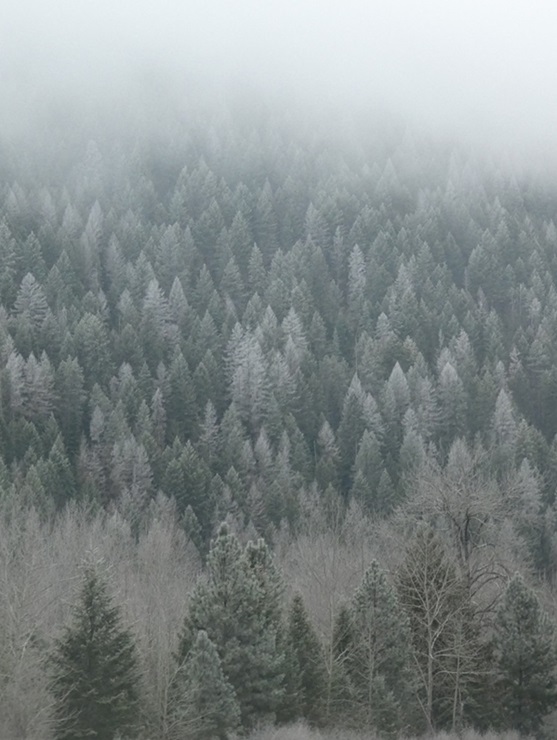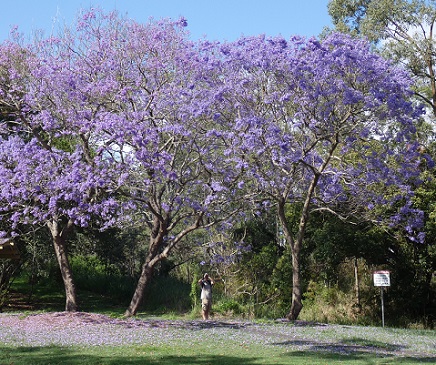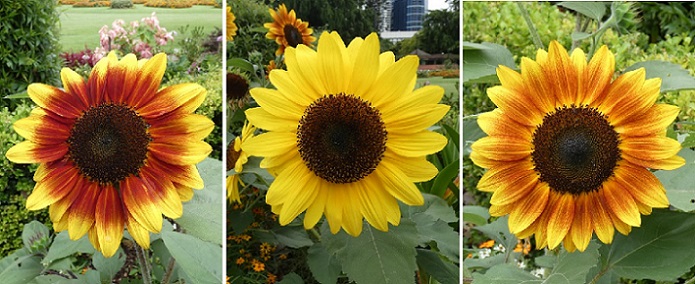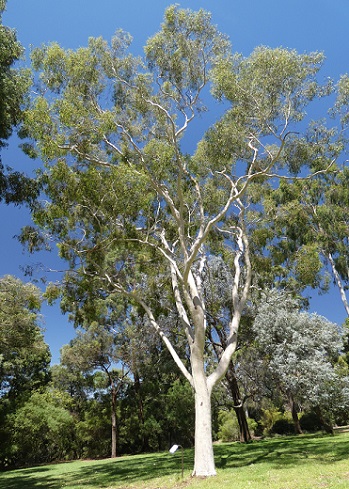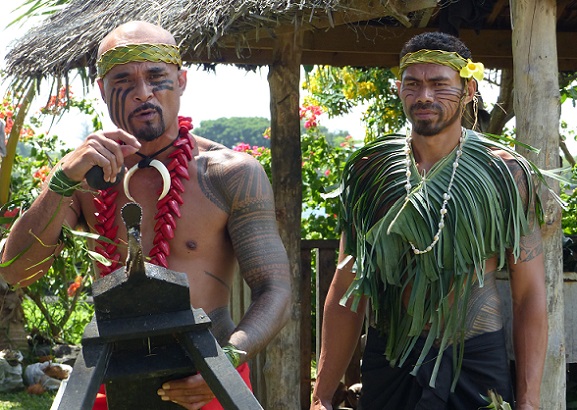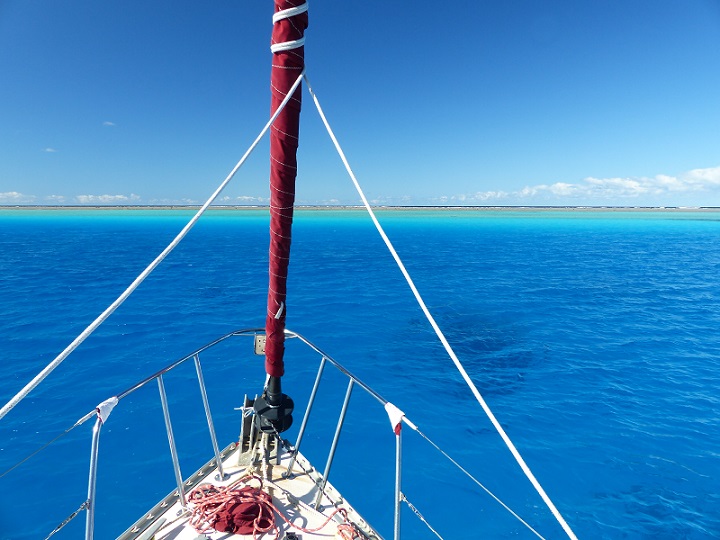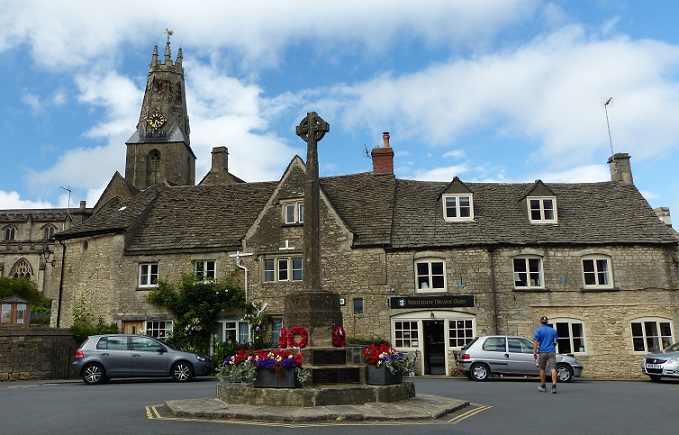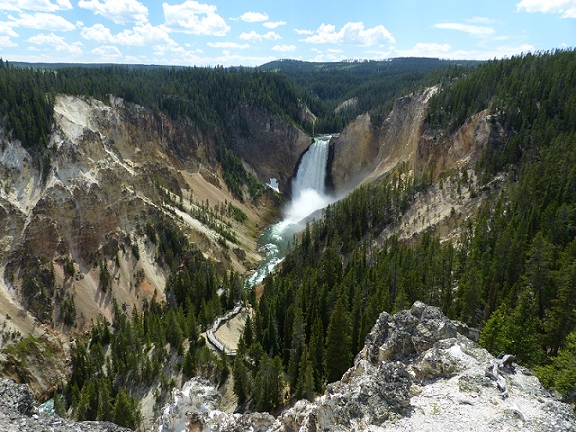
Tregoning
12 April 2024 | We are back aboard Tregoning in Mersin Marina, Mersin, Türkiye
02 April 2024 | We are in Toronto Airport, Canada: Tregoning is in Mersin Marina, Mersin, Türkiye
25 February 2024 | We are back in Gainesville, FL: Tregoning is in Mersin Marina, Mersin, Türkiye
18 February 2024 | We are in Glenwood, New Mexico: Tregoning is in Mersin Marina, Mersin, Türkiye
12 February 2024 | We are in Morro Bay, California: Tregoning is in Mersin Marina, Mersin, Türkiye
19 January 2024 | We are in Vancouver, BC Canada: Tregoning is in Mersin Marina, Mersin, Türkiye
01 January 2024 | We are in Washington State: Tregoning is in Mersin Marina, Mersin, Türkiye
15 December 2023 | We are in Minnesota: Tregoning is in Mersin Marina, Mersin, Türkiye
18 November 2023 | We are in Florida: Tregoning is in Mersin Marina, Mersin, Türkiye
29 October 2023 | We're in Florida - Tregoning is at B-dock, Mersin Marina, Mersin, Türkiye
21 October 2023 | 7 Oda Kapadokya Cave Hotel, Ürgüp, Türkiye
14 October 2023 | Hotel Aşikoğlu, Boğazkale, Türkiye
07 October 2023 | B-dock, Mersin Marina, Mersin, Türkiye
19 September 2023 | “Chez Jon & Angela”, Near Otterton, Devon, UK
14 September 2023 | Airbnb in Fortuneswell on the Isle of Portland, Dorset, UK
11 September 2023 | With Mike, Grange-over-Sands, Cumbria, UK
03 September 2023 | Ardington House, Ardington, Oxfordshire, UK
24 August 2023 | Near "Chez Joan and Peter", College of Roseisle, Moray, Scotland
11 August 2023 | Andrew's house (not exactly), Lichfield, UK
22 July 2023 | Chez Gail, near the New York Café, Budapest, Hungary
Having a whale of a time!
04 August 2017 | Northwest side of Ha'afeva Island, Ha'apai Group, Tonga
Photo: Three humpback whales turning in 20-feet deep (6 m) water between Tregoning and the double-masted catamaran, Cactus Island: L to R, calf, mother, and escort-male
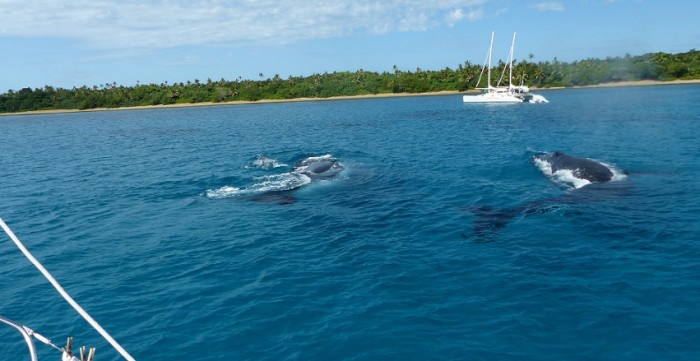
We really like this anchorage. We are anchored in the middle of a big sand circle just 20 - 26 feet deep (6 to 8 m) with no danger of the chain touching any coral. The spot is not immune to rolling when the wind comes from anywhere not between NE and SSE but we are sheltered from the prevailing wind chop, and there is plenty of room for other boats and no emergent reef close behind us. It is easy to snorkel right off Tregoning, with some deeper coral behind us where bigger fish can be watched in the relatively clear water, and with a good diversity of fish and soft and hard corals in the shallower water towards the shore. Given that we get quite cold after 45 minutes in the water (or up to 90 minutes if the sun is shining), we have only been snorkeling once a day, but that frequency is still a great treat.
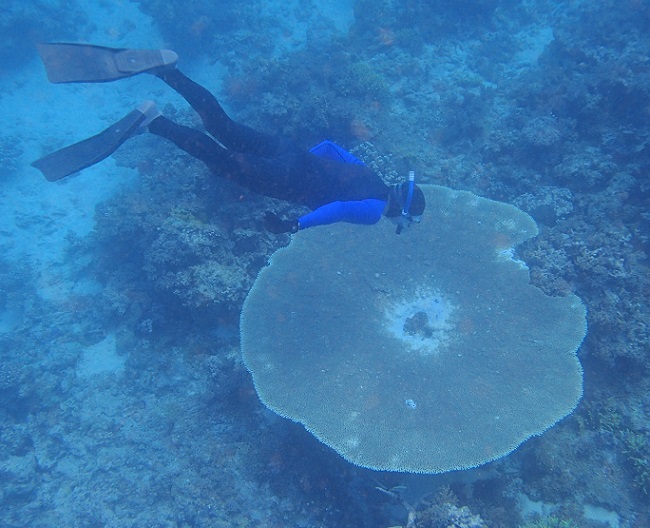
Randall swims down to look at a large table coral near Ha'afeva Island
Ha'afeva is on the western side of the rectangle that defines most of the Ha'apai Group but on the skyline to the west we can see the large, high, volcanic islands of Kao and Tofua. The northern Kao is 1,046 m high (3,431 feet), dormant, and has a classic cone shape. Tofua is flat-topped and being wider and only 507 m (1,663 feet) tall, it is not obvious that it is the bottom of a cone. It is an active volcano with a large, steaming freshwater lake in the middle and plumes of smoke are frequently emitted from near the northern end.

The volcanic islands of Tofua and Koa seen on the western horizon from Ha'afeva
Tofua is perhaps best known as the nearest island to where the mutiny on the ship Bounty occurred. On 28 April 1789, Captain Bligh and 18 loyal seamen landed on Tofua after Fletcher Christian and the other mutineers had set them adrift in a small, open boat. Unfortunately, on arrival the quartermaster John Newton was clubbed to death by the islanders. Bligh and the others narrowly escaped only to embark on a 6,500 km (3,513 nm) drift west to Timor with desperately little food or water.

Smoke billows from volcanic activity on Tofua beyond a humpback whale raising its pectoral fin within the Ha'afeva Bay
It is possible to go ashore and hike to the crater rims but the paths are indistinct so guides are needed for the grueling climbs. Anchoring, on a rocky bottom, is only possible on calm days and even then it is recommended that someone stay aboard. So we will content ourselves with admiring rather than scaling these peaks. However, for the first part of our stay, at least, the most captivating aspect of the anchorage was the whale activity.
By the second morning of our visit to Ha'afeva (Monday, July 31st), three mother and calf pairs of humpback whales were within the bay defined by the island and the fringing reef about 1 nm to the west. These whales had probably spent the night in the bay and after some morning activities, which we thoroughly enjoyed watching through the binoculars, it seemed as though they had all gradually moved out by 10 am.

Submerged mother and emerging calf seen from Tregoning's stern (the closer escort-male follows)
During the afternoon, two large whales and one calf swam very close to the stern of Tregoning, then turned around and swam back. This close proximity was very exciting and we were tremendously lucky that it was sunny and the water was so clear. A little while later, the same group swam very close to Tregoning's bow, turned between us and the only other boat in the bay (SV Cactus Island) that was anchored inshore of us, and then back past Tregoning's bow.
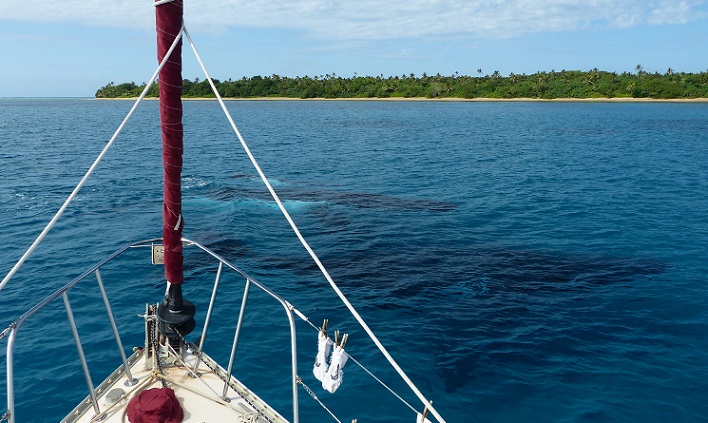
Submerged whales pass close to Tregoning's bow
Seeing the whales approach, I slipped into the water with mask and snorkel but I had no time to grab the camera. I did not wear fins so that I would not tempted to swim nearer to the whales and I deliberately held onto the dinghy painter or stayed in touch with Tregoning's hull. People are only allowed to follow whales or go snorkeling with them from commercial boats that have trained crews that have been licensed to participate in whale-watching. By getting in the water, I was probably somewhat distending the rules but I rationalized that by staying with our anchored boat, the whales had come to me and that by simply hanging in the water, I was probably not altering their behavior. Or so my situational ethics flexed enough to let me sleep that night...
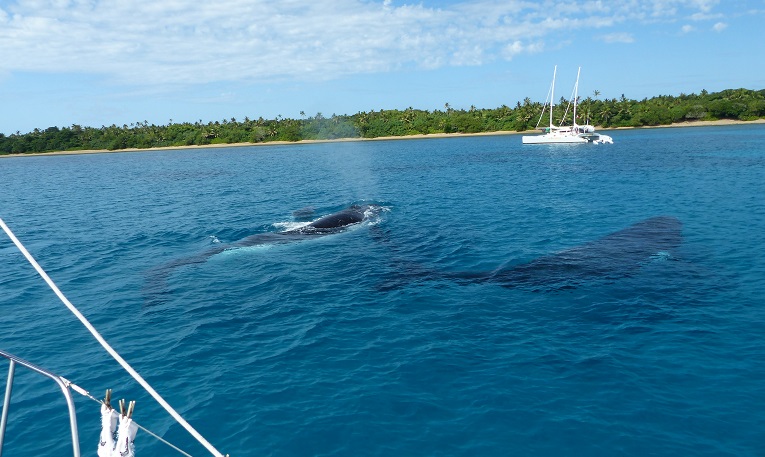
After passing Tregoning's bow the large male (right submerged) and spouting female (the calf is submerged beyond her) approach SV Cactus Island before turning around
While underwater, I saw both of the adult whales which was very, very cool and heard them all communicating in low moans and higher-pitched squeaks. That evening, when we had drinks with Maree and Gerald on their homemade, double-masted catamaran Cactus Island (a slang name for Australia from whence they came), Maree guessed that we had seen a mother and calf with an escort male. We wondered if the whales had come so close just to have a look at us, maybe to show the calf what to avoid, or if they liked to use the sandy area where we were anchored as a resting or scratching place. While we were pretty sure that humpback whales are smart enough to recognize boat hulls, we did wonder if they could see and avoid our anchor chain or if we had been lucky that they had not caught it and dragged us around for a while; the male had been so very close.
We never saw the whales come anywhere close to anchored boats again but for a few more days within the bay, we were treated to exhibitions of calves breaching, and pectoral fin- and tail-slapping by both calves and adults. The loud smacks of the latter were often preceded by loud, deep groans that sounded most satisfying. Later in the week, the live-aboard dive/whale-watching boat Nai'a stayed for a couple of nights. They spent the intervening day with two groups watching and snorkeling with the whales, both inside and outside the bay. We did not see any whales inside the bay that evening or for another few days.
We will never know whether the absence of whales in the bay after the day of whale-snorkeling activities was a coincidence or a consequential change in behavior, but some of them did eventually reappear. Subsequent neighbors, Amy and David on another catamaran SV Starry Horizons, suggested that the females may be coming into the bay to give birth and then leave when the calves are old enough go outside. That would be particularly cool.
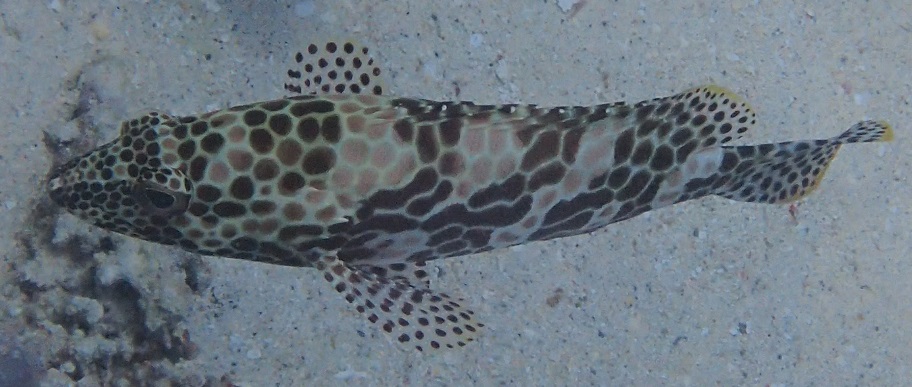
A honeycomb grouper (up to 32 cm or 13 inches)
Even when the whales were temporarily absent, we still had plenty of places to snorkel to keep us happy with the anchorage. My joy was almost derailed when I realized that one of my fins was developing a split that started on one side and threatened to cross the whole the blade, shortening the fin to be little longer than the foot-pocket. Luckily, Randall was able to drill small holes in the plastic on either side of the tear and use stainless steel seizing-wire to hold the sides of the tear together. So far so good. There are dive operators in Naiafu, Vava'u that may have some decent fins for sale, otherwise, I will have to hope that Randall can keep it repaired until we return to New Zealand.
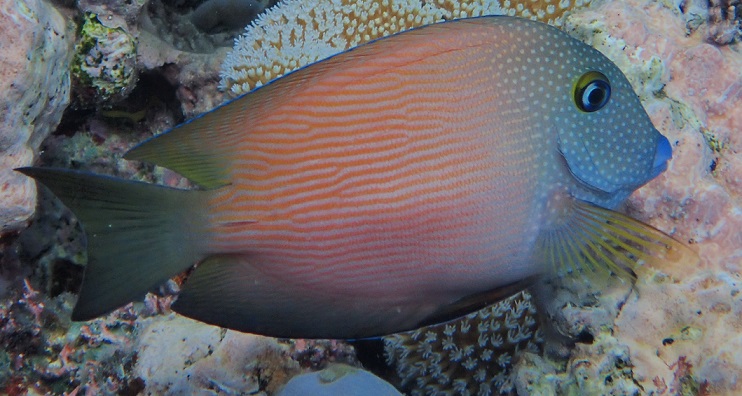
Bluelipped bristletooth (up to 20 cm or 8 inches)
A short dinghy ride to the north end of the island revealed a large network of fairly shallow coral heads that could be swum between, but the fish and limited amounts of living coral were not very interesting. Putting the outboard on the dinghy and crossing the bay to the inside of the southwestern corner of the reef proved to be much more worthwhile. Anchoring the dinghy near the emergent black triangle of the wreck of Ekiaki, a Korean fishing vessel, we could swim south along the edge of reef that sat in sand at the relatively shallow depth of 10 feet (or 3 m). Swimming north, took us around an island of reef that had walls up to about 26 feet (8 m) deep and which included branching canyons within the reef, a favorite of Randall's.
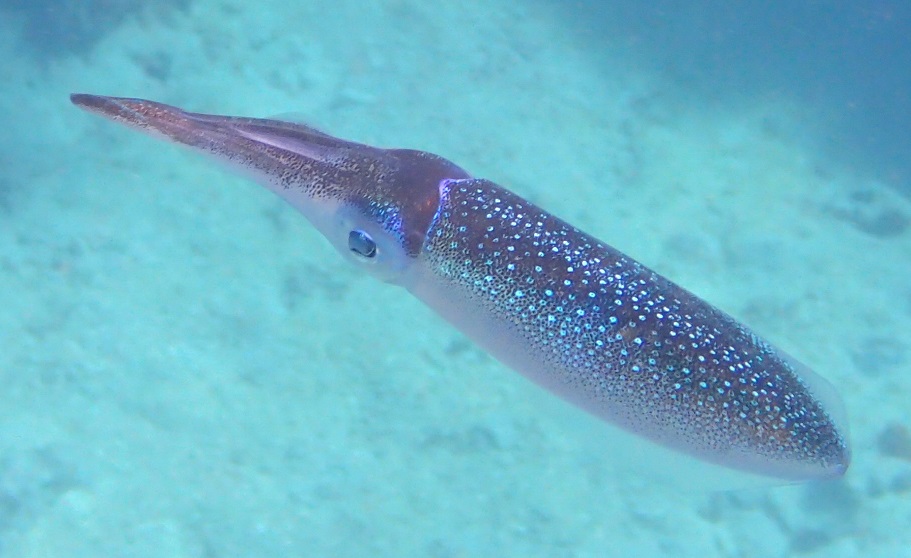
A squid in Ha'afeva Bay (about 20 cm or 8 inches)
In either direction, the colors and diversity of shapes of soft and hard corals were spectacular. The fish were plentiful and diverse and on the wreck, I saw the largest trumpetfish that I have ever seen. In addition to seeing squid and a small octopus, fish species around Ha'afeva that were new to me included: Black snapper, reticulated dascyllus, imitator damsel, blotcheye soldierfish, tiger cardinalfish, southern tubelip, blackheaded filefish, and a pair of lemon coralgobies.

A diversity of hard corals south of the wreck at Ha'afeva
The snorkeling site around the wreck was mentioned in the cruising guides but had also been specifically recommended to us by Phil on SV Silhouette and, as he had suggested, it greatly reminded us of snorkeling in the Tuamotu and Society Islands of French Polynesia. If Phil is having a good time in Fiji, we may have to persuade him to give us all of his snorkeling and anchoring recommendations there too because he has not led us astray so far.

Initial adult phase of the ring wrasse (up to 25 cm or 10 inches)

Randall swims down to look at a large table coral near Ha'afeva Island
Ha'afeva is on the western side of the rectangle that defines most of the Ha'apai Group but on the skyline to the west we can see the large, high, volcanic islands of Kao and Tofua. The northern Kao is 1,046 m high (3,431 feet), dormant, and has a classic cone shape. Tofua is flat-topped and being wider and only 507 m (1,663 feet) tall, it is not obvious that it is the bottom of a cone. It is an active volcano with a large, steaming freshwater lake in the middle and plumes of smoke are frequently emitted from near the northern end.

The volcanic islands of Tofua and Koa seen on the western horizon from Ha'afeva
Tofua is perhaps best known as the nearest island to where the mutiny on the ship Bounty occurred. On 28 April 1789, Captain Bligh and 18 loyal seamen landed on Tofua after Fletcher Christian and the other mutineers had set them adrift in a small, open boat. Unfortunately, on arrival the quartermaster John Newton was clubbed to death by the islanders. Bligh and the others narrowly escaped only to embark on a 6,500 km (3,513 nm) drift west to Timor with desperately little food or water.

Smoke billows from volcanic activity on Tofua beyond a humpback whale raising its pectoral fin within the Ha'afeva Bay
It is possible to go ashore and hike to the crater rims but the paths are indistinct so guides are needed for the grueling climbs. Anchoring, on a rocky bottom, is only possible on calm days and even then it is recommended that someone stay aboard. So we will content ourselves with admiring rather than scaling these peaks. However, for the first part of our stay, at least, the most captivating aspect of the anchorage was the whale activity.
By the second morning of our visit to Ha'afeva (Monday, July 31st), three mother and calf pairs of humpback whales were within the bay defined by the island and the fringing reef about 1 nm to the west. These whales had probably spent the night in the bay and after some morning activities, which we thoroughly enjoyed watching through the binoculars, it seemed as though they had all gradually moved out by 10 am.

Submerged mother and emerging calf seen from Tregoning's stern (the closer escort-male follows)
During the afternoon, two large whales and one calf swam very close to the stern of Tregoning, then turned around and swam back. This close proximity was very exciting and we were tremendously lucky that it was sunny and the water was so clear. A little while later, the same group swam very close to Tregoning's bow, turned between us and the only other boat in the bay (SV Cactus Island) that was anchored inshore of us, and then back past Tregoning's bow.

Submerged whales pass close to Tregoning's bow
Seeing the whales approach, I slipped into the water with mask and snorkel but I had no time to grab the camera. I did not wear fins so that I would not tempted to swim nearer to the whales and I deliberately held onto the dinghy painter or stayed in touch with Tregoning's hull. People are only allowed to follow whales or go snorkeling with them from commercial boats that have trained crews that have been licensed to participate in whale-watching. By getting in the water, I was probably somewhat distending the rules but I rationalized that by staying with our anchored boat, the whales had come to me and that by simply hanging in the water, I was probably not altering their behavior. Or so my situational ethics flexed enough to let me sleep that night...

After passing Tregoning's bow the large male (right submerged) and spouting female (the calf is submerged beyond her) approach SV Cactus Island before turning around
While underwater, I saw both of the adult whales which was very, very cool and heard them all communicating in low moans and higher-pitched squeaks. That evening, when we had drinks with Maree and Gerald on their homemade, double-masted catamaran Cactus Island (a slang name for Australia from whence they came), Maree guessed that we had seen a mother and calf with an escort male. We wondered if the whales had come so close just to have a look at us, maybe to show the calf what to avoid, or if they liked to use the sandy area where we were anchored as a resting or scratching place. While we were pretty sure that humpback whales are smart enough to recognize boat hulls, we did wonder if they could see and avoid our anchor chain or if we had been lucky that they had not caught it and dragged us around for a while; the male had been so very close.
We never saw the whales come anywhere close to anchored boats again but for a few more days within the bay, we were treated to exhibitions of calves breaching, and pectoral fin- and tail-slapping by both calves and adults. The loud smacks of the latter were often preceded by loud, deep groans that sounded most satisfying. Later in the week, the live-aboard dive/whale-watching boat Nai'a stayed for a couple of nights. They spent the intervening day with two groups watching and snorkeling with the whales, both inside and outside the bay. We did not see any whales inside the bay that evening or for another few days.
We will never know whether the absence of whales in the bay after the day of whale-snorkeling activities was a coincidence or a consequential change in behavior, but some of them did eventually reappear. Subsequent neighbors, Amy and David on another catamaran SV Starry Horizons, suggested that the females may be coming into the bay to give birth and then leave when the calves are old enough go outside. That would be particularly cool.

A honeycomb grouper (up to 32 cm or 13 inches)
Even when the whales were temporarily absent, we still had plenty of places to snorkel to keep us happy with the anchorage. My joy was almost derailed when I realized that one of my fins was developing a split that started on one side and threatened to cross the whole the blade, shortening the fin to be little longer than the foot-pocket. Luckily, Randall was able to drill small holes in the plastic on either side of the tear and use stainless steel seizing-wire to hold the sides of the tear together. So far so good. There are dive operators in Naiafu, Vava'u that may have some decent fins for sale, otherwise, I will have to hope that Randall can keep it repaired until we return to New Zealand.

Bluelipped bristletooth (up to 20 cm or 8 inches)
A short dinghy ride to the north end of the island revealed a large network of fairly shallow coral heads that could be swum between, but the fish and limited amounts of living coral were not very interesting. Putting the outboard on the dinghy and crossing the bay to the inside of the southwestern corner of the reef proved to be much more worthwhile. Anchoring the dinghy near the emergent black triangle of the wreck of Ekiaki, a Korean fishing vessel, we could swim south along the edge of reef that sat in sand at the relatively shallow depth of 10 feet (or 3 m). Swimming north, took us around an island of reef that had walls up to about 26 feet (8 m) deep and which included branching canyons within the reef, a favorite of Randall's.

A squid in Ha'afeva Bay (about 20 cm or 8 inches)
In either direction, the colors and diversity of shapes of soft and hard corals were spectacular. The fish were plentiful and diverse and on the wreck, I saw the largest trumpetfish that I have ever seen. In addition to seeing squid and a small octopus, fish species around Ha'afeva that were new to me included: Black snapper, reticulated dascyllus, imitator damsel, blotcheye soldierfish, tiger cardinalfish, southern tubelip, blackheaded filefish, and a pair of lemon coralgobies.

A diversity of hard corals south of the wreck at Ha'afeva
The snorkeling site around the wreck was mentioned in the cruising guides but had also been specifically recommended to us by Phil on SV Silhouette and, as he had suggested, it greatly reminded us of snorkeling in the Tuamotu and Society Islands of French Polynesia. If Phil is having a good time in Fiji, we may have to persuade him to give us all of his snorkeling and anchoring recommendations there too because he has not led us astray so far.

Initial adult phase of the ring wrasse (up to 25 cm or 10 inches)
Comments
| Vessel Name: | Tregoning |
| Vessel Make/Model: | Morgan Classic 41 |
| Hailing Port: | Gainesville, FL |
| Crew: | Alison and Randall |
| About: | We cast-off from Fernandina Beach in north Florida on 1st June 2008 and we have been cruising on Tregoning ever since. Before buying Tregoning, both of us had been sailing on smaller boats for many years and had worked around boats and water throughout our careers. |
| Extra: | “Tregoning” (rhymes with “belonging”) and is a Cornish word (meaning “homestead of Cohnan” or “farm by the ash trees”) and was Alison's mother’s middle name. Cornwall is in southwest England and is where Alison grew-up. |
Tregoning's Photos - Main
 |
Extra photographs from our three-week campervan tour of the South Island from November 15th to December 5th 2015
217 Photos
Created 4 January 2016
|
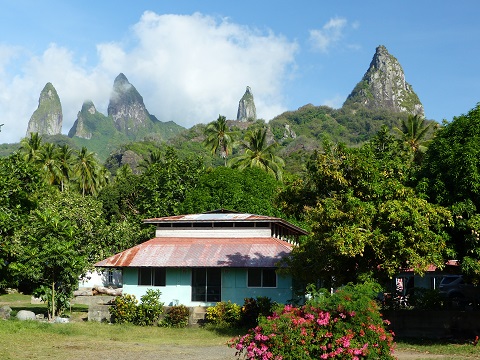 |
Random pictures from our month spent on the islands of Hiva Oa, Tahuata, Ua Pou, and Nuku Hiva
45 Photos
Created 18 July 2015
|
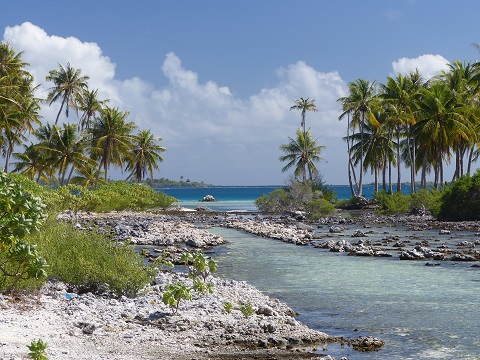 |
Random pictures from our month spent in 4 Tuamotu Atolls; Ahe, Fakarava, Tahanea, and Toau
32 Photos
Created 1 July 2015
|
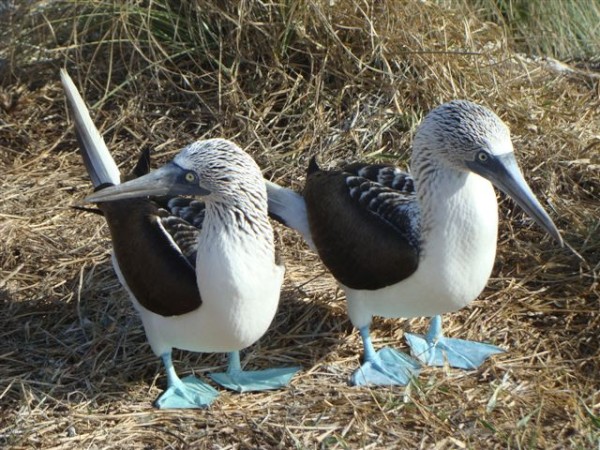 |
Some of the birds, fish, reptiles, and mammals (and others) that we have seen in Mexico
74 Photos
Created 5 May 2014
|
Tregoning

Who: Alison and Randall
Port: Gainesville, FL
